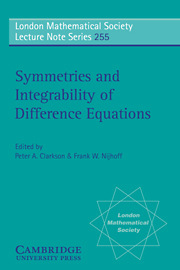Book contents
- Frontmatter
- Contents
- Preface
- List of Participants
- 1 Partial Difference Equations
- 2 Integrable Mappings
- 3 Discrete Geometry
- 4 Asymptotic Analysis
- 5 Discrete Painlevé Equations
- 6 Symmetries of Difference Equations
- 7 Numerical Methods and Miscellaneous
- 8 Cellular Automata
- Soliton Cellular Automata
- Painlevé equations and cellular automata
- Soliton cellular automaton
- 9 q-Special Functions and q-Difference Equations
- 10 Quantum Aspects and Yang-Baxter Equations
Soliton Cellular Automata
Published online by Cambridge University Press: 04 August 2010
- Frontmatter
- Contents
- Preface
- List of Participants
- 1 Partial Difference Equations
- 2 Integrable Mappings
- 3 Discrete Geometry
- 4 Asymptotic Analysis
- 5 Discrete Painlevé Equations
- 6 Symmetries of Difference Equations
- 7 Numerical Methods and Miscellaneous
- 8 Cellular Automata
- Soliton Cellular Automata
- Painlevé equations and cellular automata
- Soliton cellular automaton
- 9 q-Special Functions and q-Difference Equations
- 10 Quantum Aspects and Yang-Baxter Equations
Summary
Abstract
We shall review some of the past work on cellular automata and its connection with solitons. We suggest possible extensions of this work to higher dimensions.
Introduction
Cellular automata have been studied for many years. Much of the work has been connected not to coherent structures but rather to pattern formation, chaos, biologicalsystems, dynamical systems and computer oriented applications to name but a few areas. There had been some discussion of coherent structures, for example in ‘the game of life’ and Margolus' billiard ball models.
In 1986 Park, Steiglitz and Thurston proposed a filter automaton, this is atype of automaton where newly calculated lattice sites are put to use immediately. Some of these automata support coherent structures and these structures have good interaction properties. This led to the idea of a solitary wave or particle and a soliton in such a discrete system. A solitary wave is taken to be a periodicpattern of non-zero cell values which propagates with a finite constan t velocity. A collision is described as solitonic if these particles retain there structure after a collision.
Fokas, Papadopoulou, Saridakis and Ablowitz examined this kind of cellular automaton in detail and looked at the ‘solitonic’ interactions within this system, deriving several analytic results about the system. In 1990 Takahashi and Satsuma also proposed an automaton with soliton solutions, this system is particularly interesting as its only solutions are solitons. In sections 2 and 3 we shall discuss these two systems (PS&T's and T&S's). In section 4 we shall loo k at possible ways of moving into higher dimensions.
- Type
- Chapter
- Information
- Symmetries and Integrability of Difference Equations , pp. 313 - 324Publisher: Cambridge University PressPrint publication year: 1999

